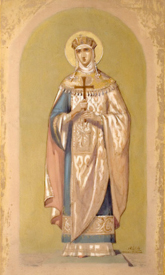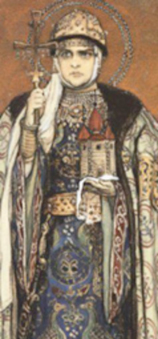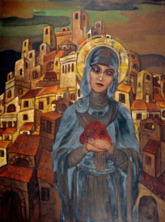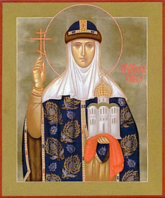✠✠✠✠✠
Princess Olha's life was full of great deeds described in numerous historical records, as well as legendary facts that are still disputed by historians today.
According to the most traditional theory, recorded in the Primary Chronicle, Olha was born in Pskov (currently a city in the northwest of Russia) into a family of Varyag origin. Varyags were also known as Vikings or Norsemen, who came to the territory of current Russia, Ukraine and Belarus during the 8th and 9th centuries. This theory about Olha's birth also explains the origin of her name, which is derived from the Scandinavian "Helga." Other historical versions state that Olha was either a daughter of Oleg Veshchy, the founder of the state of Kyivan Rus', or had Bulgarian roots.
Oleg Veshchy initiated Olha's marriage with Prince Ihor, who was the son of the Novgorod Prince Rurik, a founder of the Rurik Dynasty of Russian tsars. After the death of Oleg in 912, Ihor became the ruler of Kyivan Rus'. In 945 Prince Ihor went to the Slavic tribe of the Drevlyans to gather tributes. After he demanded a much higher payment, the Drevlyans killed him.
The death of the Kyivan Prince raised a question about the next ruler of the country. Ihor's son, Svyatoslav, was only three years old, and hence Olha took the power into her hands. Interestingly, she had the full support the Rus' army, which attests to the great respect she held among the people.
After killing Ihor, the Drevlyans sent their matchmakers to propose that Olha marry their Prince Mal. The Princess took revenge upon her husband's death, killing all of the ambassadors.
The Old Russian annals describe four types of vengeance organized by Olha. First, she ordered the capture of the 20 matchmakers who had come to Kyiv and had them buried alive. The Princess then asked the Drevlyans to send better ambassadors to her, but as soon as they arrived, they were burned in a bathhouse. Soon after that Olha went to the land of the Drevlyans, supposedly to have a funeral feast in memory of her murdered husband. Having made her enemies drunk during the feast, the governess then ordered them all killed. The annals report about five thousand victims in this third act of revenge.

The last vengeance took place in the year 946 when Olha travelled around the land of the Drevlyans in order to gather tributes. She besieged the town of Iskorosten, which refused to pay her. According to legend, the Princess asked that each household present her with a dove as a gift. Then she tied burning papers to the legs of the doves and let them fly back to their homes. As a result, the entire town was destroyed by fire.
Olha's rule over Kyivan Rus' officially lasted until her son reached his full age. Having grown up, Svyatoslav preferred to spend most of his time abroad, organizing military campaigns in order to widen and strengthen the borders of his state.
Olha, left in charge of the internal policies of Kyivan Rus', became known for establishing the system of tribute gathering, which is sometimes considered to be the first legal tax system in Eastern Europe. She ordered the creation of centers of trade and taxation. The lands subjugated to Kyiv were divided into administrative units, which were controlled by the Princess's representatives. Olha set fixed amounts of tributes, with a detailed schedule for their gathering.
Princess Olha is also thought to have been the initiator of the first stone city building in Kyivan Rus', especially in the cities of Kyiv, Novgorod and Pskov.
One of the most well-known of Olha's actions was her conversion to Christianity. She was one of the first to bring this religion to the pagan society of Kyivan Rus'. According to the Primary Chronicles, Olha was baptised in Constantinople either in 955 or 957. Her son Svyatoslav didn't support his mother's decision and was worried about losing the respect of the army because of Olha's new faith. Apparently, she had a big influence on her grandson, Volodymyr the Great, who in 988 made Christianity the official religion of Kyivan Rus'.

In 957 Olha paid an official visit to the Byzantine emperor, Constantine VII, in Constantinople. Presumably, the negotiations didn't bring the expected results, since the historical records describe a cold greeting for the Byzantine ambassadors during their return visit to Kyiv.
Western European sources mention that in 959 Olha sent her ambassadors to Otto I, the Emperor of the Roman Empire, asking them to appoint an archbishop and priests to serve in her country. The chronicle accuses the Princess's envoys of lying, but details in conflicting historical records make it is difficult to say whether Olha was sincere in her request or not. The Emperor's bishop, Adalbert of Magdeburg, having spent some time in Kyivan Rus', decided that all his efforts to develop Christianity in the country were in vain. On his way back to Italy all his companions were killed (supposedly) by Svyatoslav's allies, and Adalbert himself barely survived.
At the time the Christian church was not yet divided into Roman and Greek branches. The separation officially took place in 1054, though in fact it had began a long time before that. Olha's attempts to build connections with both the Byzantine and Roman Emperors, the highest church authorities, are assessed differently. She either hesitated about which to choose or conducted a forward-looking policy of bringing pressure on Constantinople, in order to gain the most beneficial positions in the Eastern Christian Church.

It is difficult to say when Svyatoslav began his full reign; though up to 959 both Byzantine and Western European records name Olha as the main ruler of Kyivan Rus'. Apparently, Svyatoslav shared power with Olha until her death.
In 968, when Svyatoslav was away conducting a military campaign, Kyiv was attacked by the Pechenegs, a semi-nomadic Turkic people. Princess Olha, together with her young grandchildren, had to organize the defense of the city. She died soon after Kyiv's siege in 969. In honor of his mother's will, Svyatoslav ordered Olha buried according to Christian canons.
In 1547 the Eastern Church proclaimed Princess Olha a saint and equal-to-the-apostles. She became one of only five women to be honoured with this status in the history of Christianity.
Troparion — Tone 1
Giving your mind the wings of divine understanding, / you soared above visible creation seeking God the Creator of all. / When you had found Him, you received rebirth through baptism. / As one who enjoys the Tree of Life, / you remain eternally incorrupt, ever-glorious Olha.
Kontakion — Tone 4
Today let us praise God the Benefactor of all, / who glorified divinely-wise Olha, / that through her prayers, He may grant our souls remission of sins.
✠✠✠✠✠
The Miracle of Saint Euphemia the All-Praised: The holy Great Martyr Euphemia (September 16) suffered martyrdom in the city of Chalcedon in the year 304, during the time of the persecution against Christians by the emperor Diocletian (284-305). One and a half centuries later, at a time when the Christian Church had become victorious within the Roman Empire, God deigned that Euphemia the All-Praised should again be a witness and confessor of the purity of Catholic Teaching.
In the year 451 in the city of Chalcedon, in the very church where the glorified relics of the holy Great Martyr Euphemia rested, the sessions of the Fourth Ecumenical Council (July 16) took place. The Council was convened for determining the precise dogmatic formulae of the Catholic Church concerning the nature of the God-Man Jesus Christ. This was necessary because of the widespread heresy of the Monophysites [“mono-physis” meaning “one nature”], who opposed the Catholic teaching of the two natures in Jesus Christ, the Divine and the Human natures (in one Divine Person). The Monophysites falsely affirmed that in Christ was only one nature, the Divine [i.e. that Jesus is God but not man, by nature], causing discord and unrest within the Church. At the Council were present 630 representatives from all the local Christian Churches. On the Catholic side, Anatolius, Patriarch of Constantinople (July 3), Juvenal, Patriarch of Jerusalem (July 2), and representatives of Saint Leo, Pope of Rome (February 18) participated in the conciliar deliberations. The Monophysites were present in large numbers, headed by Dioscorus, the Patriarch of Alexandria, and the Constantinople archimandrite Eutychius.
After prolonged discussions, the two sides could not come to a decisive agreement.
The holy Patriarch Anatolius of Constantinople proposed that the Council submit the decision of the Church dispute to the Holy Spirit, through His undoubted bearer Saint Euphemia the All-Praised, whose wonderworking relics had been discovered during the Council’s discussions. The Catholic hierarchs and their opponents wrote down their confessions of faith on separate scrolls and sealed them with their seals. They opened the tomb of the holy Great Martyr Euphemia and placed both scrolls upon her bosom. Then, in the presence of the emperor Marcian (450-457), the participants of the Council sealed the tomb, putting on it the imperial seal and setting a guard to watch over it for three days. During these days both sides imposed upon themselves a strict fast and made intense prayers. After three days the patriarch and the emperor in the presence of the Council opened the tomb with its relics: the scroll with the Catholic confession was held by Saint Euphemia in her right hand, and the scroll of the heretics lay at her feet. Saint Euphemia, as though alive, raised her hand and gave the scroll to the patriarch. After this miracle, many of the hesitant accepted the Catholic confession, while those remaining obstinant in the heresy were consigned to the Council’s condemnation and excommunication.
After an invasion by the Persians during the seventh century, the relics of Saint Euphemia were transferred from Chalcedon to Constantinople, into a newly built church dedicated to her. Many years later, during the period of the Iconoclast heresy, the reliquary with the relics of the saint was cast into the sea by order of the Iconoclast emperor Leo the Isaurian (716-741). The reliquary was rescued from the sea by the ship-owning brothers Sergius and Sergonos, who gave it over to the local bishop. The holy bishop ordered that the relics be preserved in secret, beneath a crypt, since the Iconoclast heresy was continuing to rage. A small church was built over the relics, and over the reliquary was put a board with an inscription stating whose relics rested within. When the Iconoclast heresy was finally condemned at the holy Seventh Ecumenical Council (in the year 787), during the time of Saint Tarasius, Patriarch of Constantinople (784-806) and the emperor Constantine VI (780-797) and his mother Saint Irene (797-802), the relics of the holy Great Martyr Euphemia were once again solemnly transferred to Constantinople.
Troparion — Tone 3
You brought joy to the OCatholic People / and shame to the defenders of heresy, / for you confirmed what the Fathers of the Fourth Council had correctly taught. / Glorious martyr Euphemia, fair virgin of Christ, / entreat Christ God to grant us His great mercy.
Kontakion — Tone 2
For the sake of Christ your Bridegroom / you underwent struggles in both martyrdom and faith. / Now intercede with the Mother of God / that heresies and the insolent enemies of the True Faith be placed underfoot. / You received and guarded that which was defined by the six hundred and thirty God-bearing Fathers, / all-praised Euphemia.
For the sake of Christ your Bridegroom / you underwent struggles in both martyrdom and faith. / Now intercede with the Mother of God / that heresies and the insolent enemies of the True Faith be placed underfoot. / You received and guarded that which was defined by the six hundred and thirty God-bearing Fathers, / all-praised Euphemia.
✠✠✠✠✠
The Hoshiv miracle-working icon of the Blessed Virgin Mary is a copy of the miraculous Belz (Czestochowa) Virgin, who was famous for her miracles from the 14th century during her stay in the xpam of the Belz Castle. At the end of the same century, it was transported to Poland, to the town of Częstochowa. Information about the miraculous copy dates back to the first half of the 18th century. It was kept in the house of the nobleman Andrii Shugai from the village of Khorobrova in the Ternopil Region. Once, during a fire that destroyed a nobleman's house, only one wall survived, on which this icon hung. This strange incident instilled vipy in the miracle of the icon and increased its veneration in the Shugai family. Later, when spontaneous peasant riots reached Khorobrov, Shugai's daughters moved to the village of Dunaiv in the Przemyśl region, to the Hoshivskyi family, and took the icon with them. When returning home to Khorobriv,
In 1736, the face of the Mother of God on the miraculous icon was covered, as if by sweat, with small drops of dew, and tears flowed from her eyes. Then Hoshivsky handed the icon over to the Dunaevsky Roman Catholic Church for veneration. During the year, the miraculous icon was in the sacristy of the church and was not available for wide veneration due to the fact that xpam already had two miraculous icons - the Icyca of Christ and the Suffering Mother of God. This state of affairs did not satisfy Hoshivskyi, and he appealed to the Metropolitan of Lviv, Athanasius Sheptytskyi, to recognize the icon as miraculous. The icon is transported from the church to the Hoshivsky estate in Hoshiv. After the testimony was heard, by the letter of Bishop Athanasius Sheptytsky fromOn July 11, 1737, the icon was recognized as miraculous. On August 5 of the same year, the icon was solemnly transferred to the monastery church on Yasnaya Gopa. On the same day, a miracle happened, which was the first to be recorded in the monastery annals:
"The day before, Kunekunda Sadovska, a resident of the village of Semigynova in the Stryi region, recovered by the grace of the Mother of God. On the eve,On August 4 (Saturday), her husband was at the evening service in the village church, during which the parish priest announced that tomorrow the miraculous icon would be moved and installed in the monastery church on Yasnaya Gopi. Touched by what he heard, Matei Sadovskyi came home and, looking at the sick woman whose death the family was waiting for from day to day, in despair fell on the bed with a cross and began to sincerely ask the Mother of God of Hoshiv to help his wife. And Matthew's prayers were heard. The wife opened her eyes and got up from the bed. The next day, when the icon was being transferred to the monastery church, the happy couple came to Hoshiv and the healed woman spoke under oath about her miraculous recovery."
Later, when the monastery was moved to Yasna Gora, the icon was placed behind the main throne.
With the liquidation of the monastery in Hoshiv, the monks secretly handed over the miraculous icon to the residents of Hoshiv. On October 14, 2001, after solemn processions in the cities and numerous villages of the Frankiv region and Lviv region, the icon returned to Yasna Gora.



No comments:
Post a Comment
Comments are subject to deletion if they are not germane. I have no problem with a bit of colourful language, but blasphemy or depraved profanity will not be allowed. Attacks on the Catholic Faith will not be tolerated. Comments will be deleted that are republican (Yanks! Note the lower case 'r'!), attacks on the legitimacy of Pope Leo XIV as the Vicar of Christ, the legitimacy of the House of Windsor or of the claims of the Elder Line of the House of France, or attacks on the legitimacy of any of the currently ruling Houses of Europe.